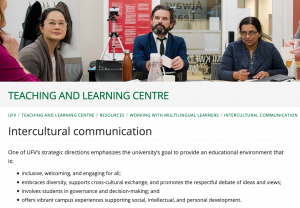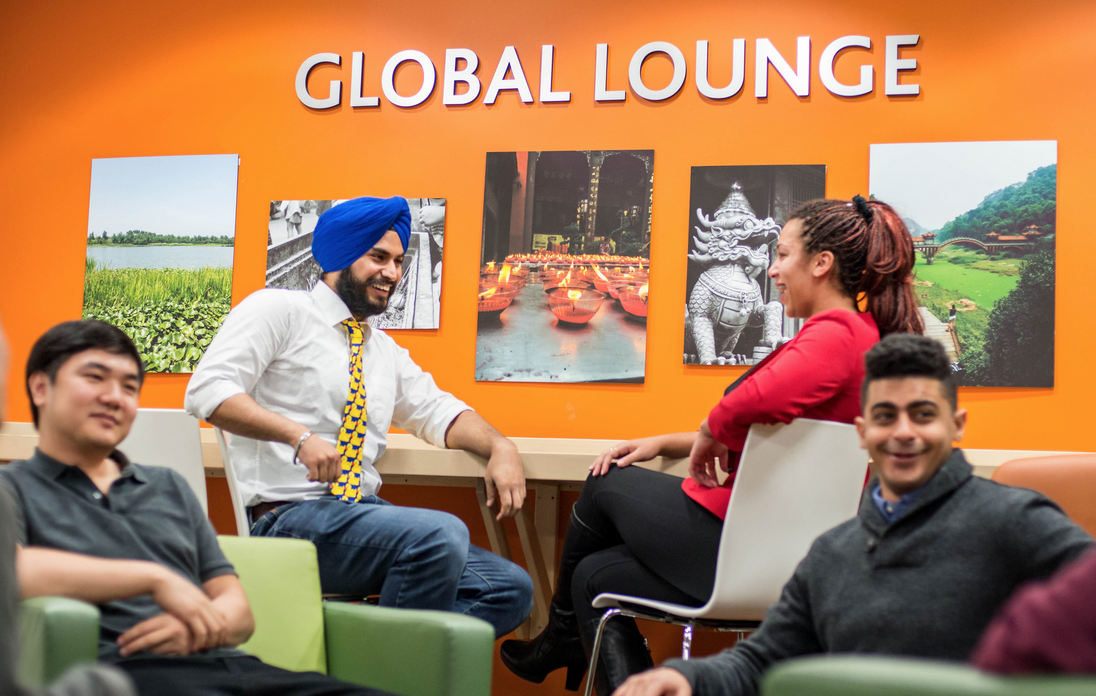Guest blog by
- Erin Pilla,
- Joban Sidhu,
- Paige Senft,
- Sumanpreet Kaur
Intercultural Communication considers the impact that culture has on the way that people create and decipher messages; how they come to understand meanings through interactions with culturally different humans.
Why is Intercultural Communication Important
Learning to become interculturally competent is important in order to eliminate stereotyping and the judgment against other groups based on the lack of knowledge that people have on other groups. At the University of the Fraser Valley (UFV) we have the privilege to delve into the world of intercultural communication, where we as students can lean each other and support each other through our educational goals. There are many opportunities to get involved with intercultural communication at UFV; there are different social groups, intercultural events, support groups and counseling to help international students settle into their lives at UFV and in Abbotsford. Students from all over the world come here to complete their post secondary education or to study abroad to gain that experience of living in another country.
UFV has partnerships for the Abroad program from all over the world. Some of the countries include:
|
Australia |
Austria |
Belgium |
Chile |
China |
Columbia |
Czech Republic |
|
Denmark |
Finland |
France |
Germany |
Hong Kong |
India |
Ireland |
|
Africa |
Japan |
Korea |
Mexico |
Netherlands |
Poland |
Scotland |
|
Singapore |
Spain |
Sweden |
Switzerland |
UAE |
U.K. |
U.S. |
Each of these countries offer different post secondary education programs to give international students a chance to grow in their education and chase their passion. The programs that are available to students range from Business and Social work to open studies, to language studies. All of these programs are offered between multiple Universities in the countries mentioned. These different groups experience each other’s way of life and become acknowledged about their traditions, cultures and norms.
How Does it Impact UFV Students
Intercultural communication allows for UFV students to expand their cultural knowledge, and meet new people to share information. University is the time of your life to explore and have new experiences, why not learn about a new culture and experience something new. Learning about each other’s cultures can reduce culture shock amongst the international students that are here for an extended period of time. Also, these opportunities let the domestic students learn about the different cultures if they do not have the opportunity to travel. They give students and faculty a chance to communicate in a variety of ways. Communicating across cultural norms allows for open mindedness, especially when considering the difficulties that some international students may face, such as: language barriers, trying to open up and not being confident to introduce themselves. The social groups and peer mentoring help the international students to be more comfortable in a new country, new environment, and new learning atmosphere.
Intercultural Communication 101 at UFV (no not the course)
Some tips on how to achieve intercultural communication:
- Stay interacting with other students
- Friends without Borders
- Hangout in the Intercultural Lounge, you get to meet other students
- Go to Student Orientation – You meet other students at the beginning of the semester
- Take an Introduction to Intercultural Communications course
What are Universities Doing to enhance Intercultural Communication?
The University of Fraser Valley also has peer to peer mentoring to help the international students. On their website, you can look at the profiles of the mentors and see which of the mentors match your personality the best.
Here is an example of a Student:

Additionally the UFV centre for Teaching and Learning offers a page full of great resources and notes about what you can glean from them. This resource is intended for everyone at UFV; students, staff, administration and faculty.
Near to home, the University of British Columbia has a website page that helps international students
Navigate find their way in life in Canada. Where they can find tutors, how to budget, how to find a doctor, and much more
Additionally, the University of Toronto has a website page dedicated to tips that professors can use in the classroom that will help international students with learning the material during lectures, which in turn will also help the domestic university students.
Let’s get personal; A UFV International student experience from one of the authors:
Q. How do you find UFV as a school?
A. UFV is a good school, more than I expected. International group lounge was very helpful in my adjustment here, the group lounge is particularly for international students to meet each other.
Q. Was your transition to UFV Easy?
A. It’s not so easy transitioning here from India, missing family and friends, and being in a new culture. Living alone and having to grocery shop, manage rent are all new things for me. I have difficulty finding a job and making new friends. UFV has many opportunities in helping make friends, different groups to join and meet people.
Q. What are some gaps you find in North American culture compared to Indian Culture?
A. There are many differences such as clothing, food, language, different styles of learning, celebrations, and different ways of greeting each other
Q. If you knew about intercultural communication when you moved to Canada, would it have made a difference in your transition?
A. YES 🙂
Activities for Communication in a Classroom
Activity #1 – Create a Poem
“ Where I’m From”
“Creating a “reflection” that communicates an affirmative personal, cultural, and linguistic identity is likely to benefit all students in class, but this pedagogical approach has been seen as particularly impactful for English language learners, whose home cultures and languages may be perceived as inferior in the mainstream social and educational environment.”
Allowing the students to write about where they are from, and the different cultures/ identities was able to help engage the students learning english as a second language a chance to give them each something to talk and show where they are from. Allowing them each to write about themselves and the place they came from gave them a sense of empowerment
Activity #2 – What Would You Do?
Time Required: 45–60 minutes: 30 minutes for activity and 30 minutes to debrief
Objectives: 1. Describe a range of “appropriate” responses in a given scenario. 2. Explore the diversity of communication styles within the group.
Materials: Post-it notes Pen or pencil for each participant Communication Styles Handout (distribute after step 3) Four pieces of poster-size paper: Each with a situation
Process: 1. Ask participants to read and decide how they would respond to each situation. 2. Have them record individual responses on Post-it notes and place them on the appropriate situation chart. 3. Ask participants to choose one charted situation to stand next to. Balance the four groups. 4. Ask each group to examine the responses to their situation. 5. Distribute the Communication Styles Handout. Review the style preferences listed on page 33. 6. Cluster responses into “style” preference.
Example Scenario: “You see someone using racist terms”
Example Response: “Say that you are not OK with that”, “Get somewhere safe”, “Get help”
Activity #3 – Personal Reflection for Transition
Time required: 75-95 minutes ( 5 minutes for setup; 20-30 minutes for completing worksheet; 20-30 minutes for small group discussion; 30 minutes for debriefing
Objectives: 1) for participants to let go of their current locations and psychologically moving on to their new location, and to reflect. 2) for participants to recognize that transitions are a process, not distinct events, and they can move on with conscious intent. 3) for participants to relax and get additional perspective and inspiration during what is typically a challenging time.
Process: answer questions about their departure and their transition into the new space.
To follow up: talk about the answers, and help the participants feel better.
References and additional resources:
Baldwin, J. R., & Levy, S. (2014). Intercultural communication for everyday life. Wiley-Blackwell. Berardo, K,. Deardorff, D.K,. Building Cultural Competence: Innovative Activities and Models. (2008) Retrieved from: https://books.google.ca/books?hl=en&id
Byram, M., Nichols, A., Stevens, D.,Developing Intercultural Competence in Practice: Languages for Intercultural Communication and Education.(2001). Retrieved from: https://books.google.ca/books?id=Twec2iPnrQgC&pg=PT123&dq=
Centre for Teaching Support & Innovation (2020), University of Toronto Retrieved From: https://teaching.utoronto.ca/teaching-support/strategies/
Connect with a Student (2020) International Students, Retrieved From: https://international.ufv.ca/study-in-canada/ask-a-global-student-associate/
Georges, S. V., & Huan, C. (2018). International Student Involvement: Leading Away from Home. Journal of Leadership Education, 17(4), 17.
Global Engagement Volunteers, International. (n.d.). Retrieved from http://international.ufv.ca/international-student-life/global-engagement-volunteers/
Gunawardena, H., & Wilson, R. (2012). International Students at University : Understanding the Student Experience. Peter Lang AG,
International Student Guide, (2020) University of British Columbia, Retrieved from: https://students.ubc.ca/international-student-guide
Ivanova, R. (2019). Using “where I’m from” poems to welcome international ESL students into U.S. academic culture. TESOL Journal, 2. https://doi.org/10.1002/tesj.399
London School of English. (2018, October 31). Learning a language – A gateway to intercultural competence. Retrieved from https://www.londonschool.com/lsic/resources/blog/learning-language-gateway-intercultural-competence/
Muscato, C.(2020) Intercultural Communication: Definition, Model & Strategies Study.Com. Retrieved From: https://study.com/academy/lesson/intercultural-communication-definition-model-strategies.html
Person. (2020, March 5). 5 Actions You Can Take To Gain Intercultural Competence. Retrieved from https://www.gviusa.com/blog/5-actions-you-can-take-to-gain-intercultural-competence/
Poitras, D. (2019). Welcoming International and Foreign Students in Canada: Friendly Relations with Overseas Students (FROS) at the University of Toronto, 1951–68. 100(1), 22–45.
Procter M. (2001) Ways to help your ESL students … and Everyone in the Process https://teaching.utoronto.ca/teaching-support/strategies/inclusive-teaching/diversity-in-the-classroom/ways-to-help-your-esl-students/
Quinlan, O., Deardorff, D. K., (2020) How universities can teach their students to respect different cultures. Retrieved from http://theconversation.com/how-universities-can-teach-their-students-to-respect-different-cultures-56857
Shapiro, S., Farrelly, R. & Tomas, Z. (2014 ). Fostering International Student Success in Higher Education. Alexandria, VA
Stringer, D.M,. Cassiday, P.A,. 52 Activities for Successful International Relocation. (2014). Retrieved From: from: https://books.google.ca/books?id=F8DGAwAAQBAJ&printsec=frontcover&source=gbs_ge_summary_r&cad=0#v=onepage&q&f=false
Stringer, D. M. & Cassiday, P. (2009) 52 Activities for Improving Cross-Cultural Communication. Boston: Intercultural Press.
Zhang, M. M., Jie Xia, D, & Zhu, J. C. (2016). Managing Student Diversity in Business Education: Incorporating Campus Diversity Into the Curriculum to Foster Inclusion and Academic Success of International Students. Academy of Management Learning & Education, 15(2), 366–380.

